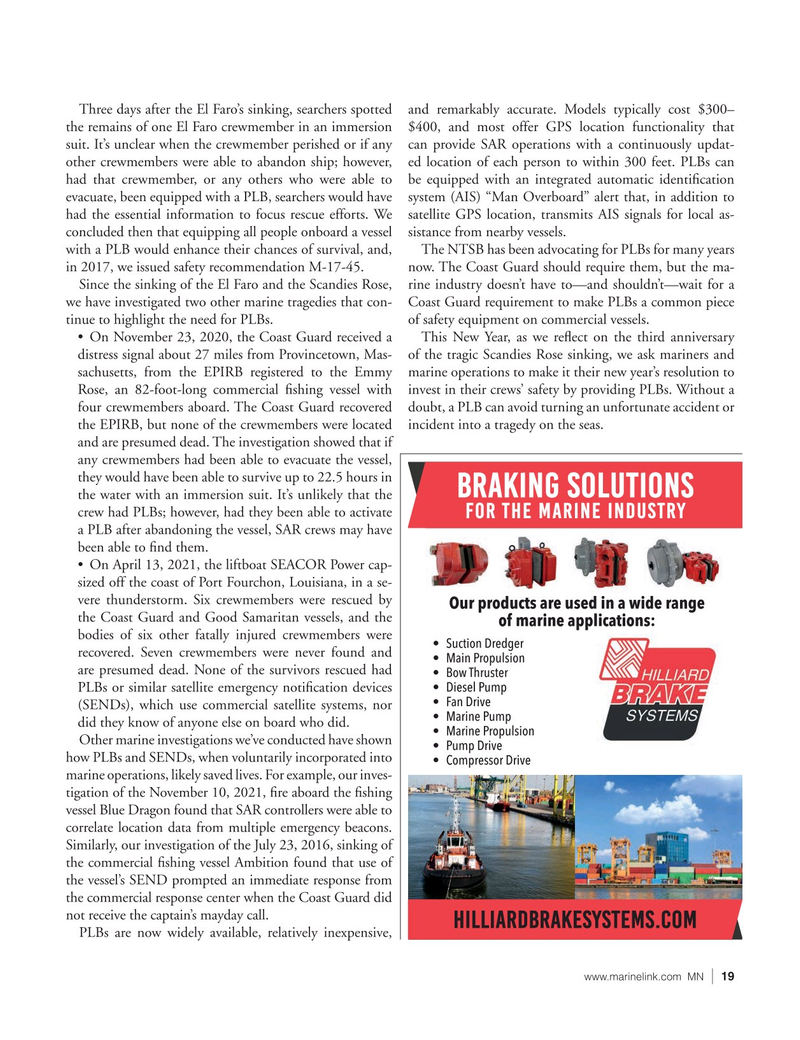
Page 19: of Marine News Magazine (February 2023)
Power & Propulsion
Read this page in Pdf, Flash or Html5 edition of February 2023 Marine News Magazine
Three days after the El Faro’s sinking, searchers spotted and remarkably accurate. Models typically cost $300– the remains of one El Faro crewmember in an immersion $400, and most offer GPS location functionality that suit. It’s unclear when the crewmember perished or if any can provide SAR operations with a continuously updat- other crewmembers were able to abandon ship; however, ed location of each person to within 300 feet. PLBs can had that crewmember, or any others who were able to be equipped with an integrated automatic identi? cation evacuate, been equipped with a PLB, searchers would have system (AIS) “Man Overboard” alert that, in addition to had the essential information to focus rescue efforts. We satellite GPS location, transmits AIS signals for local as- concluded then that equipping all people onboard a vessel sistance from nearby vessels.
with a PLB would enhance their chances of survival, and, The NTSB has been advocating for PLBs for many years in 2017, we issued safety recommendation M-17-45. now. The Coast Guard should require them, but the ma-
Since the sinking of the El Faro and the Scandies Rose, rine industry doesn’t have to—and shouldn’t—wait for a we have investigated two other marine tragedies that con- Coast Guard requirement to make PLBs a common piece tinue to highlight the need for PLBs. of safety equipment on commercial vessels.
• On November 23, 2020, the Coast Guard received a This New Year, as we re? ect on the third anniversary distress signal about 27 miles from Provincetown, Mas- of the tragic Scandies Rose sinking, we ask mariners and sachusetts, from the EPIRB registered to the Emmy marine operations to make it their new year’s resolution to
Rose, an 82-foot-long commercial ? shing vessel with invest in their crews’ safety by providing PLBs. Without a four crewmembers aboard. The Coast Guard recovered doubt, a PLB can avoid turning an unfortunate accident or the EPIRB, but none of the crewmembers were located incident into a tragedy on the seas.
and are presumed dead. The investigation showed that if any crewmembers had been able to evacuate the vessel, they would have been able to survive up to 22.5 hours in the water with an immersion suit. It’s unlikely that the crew had PLBs; however, had they been able to activate a PLB after abandoning the vessel, SAR crews may have been able to ? nd them.
• On April 13, 2021, the liftboat SEACOR Power cap- sized off the coast of Port Fourchon, Louisiana, in a se- vere thunderstorm. Six crewmembers were rescued by the Coast Guard and Good Samaritan vessels, and the bodies of six other fatally injured crewmembers were recovered. Seven crewmembers were never found and are presumed dead. None of the survivors rescued had
PLBs or similar satellite emergency noti? cation devices (SENDs), which use commercial satellite systems, nor did they know of anyone else on board who did.
Other marine investigations we’ve conducted have shown how PLBs and SENDs, when voluntarily incorporated into marine operations, likely saved lives. For example, our inves- tigation of the November 10, 2021, ? re aboard the ? shing vessel Blue Dragon found that SAR controllers were able to correlate location data from multiple emergency beacons.
Similarly, our investigation of the July 23, 2016, sinking of the commercial ? shing vessel Ambition found that use of the vessel’s SEND prompted an immediate response from the commercial response center when the Coast Guard did not receive the captain’s mayday call.
PLBs are now widely available, relatively inexpensive, www.marinelink.com MN 19|

 18
18

 20
20
